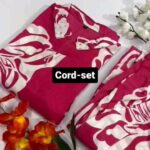Fashion garments are clothing items designed with style, aesthetics, and trends in mind, often reflecting cultural, social, or individual expressions. They range from everyday wear like tops, pants, and dresses to specialized pieces like evening gowns or streetwear, crafted with varying materials, cuts, and embellishments to suit different occasions, seasons, or personal tastes. Unlike basic clothing, fashion garments prioritize visual appeal and often follow or set trends in the industry.
Types of Fashion
Fashion is diverse and evolves constantly, but here are some major types or categories:
- Haute Couture: High-end, custom-made clothing crafted with exceptional detail and exclusivity, often seen in luxury fashion houses (e.g., Chanel, Dior).
- Ready-to-Wear (Prêt-à-Porter): Mass-produced clothing in standard sizes, balancing style and accessibility (e.g., Zara, H&M).
- Streetwear: Casual, urban-inspired fashion rooted in youth culture, often featuring bold graphics and relaxed fits (e.g., Supreme, Off-White).
- Athleisure: Comfortable, athletic-inspired clothing designed for both workouts and casual wear (e.g., Lululemon, Nike).
- Fast Fashion: Affordable, trend-driven clothing produced quickly to keep up with current styles (e.g., Shein, Forever 21).
- Sustainable/Eco-Fashion: Environmentally conscious clothing made with ethical practices and eco-friendly materials (e.g., Stella McCartney, Patagonia).
- Vintage/Retro: Clothing inspired by or sourced from past decades, celebrating nostalgic styles (e.g., 70s bohemian, 90s grunge).
- Formal/Evening Wear: Elegant garments for special occasions, like gowns, tuxedos, or cocktail dresses.
- Casual Fashion: Everyday, relaxed clothing prioritizing comfort and versatility (e.g., jeans, t-shirts).
- Cultural/Traditional Fashion: Garments reflecting specific cultural or regional identities (e.g., sarees, kimonos, kilts).
- Avant-Garde: Experimental, boundary-pushing designs that challenge conventional fashion norms, often seen in high-concept runway shows.
- Minimalist Fashion: Simple, clean designs with neutral colors and timeless appeal (e.g., COS, Uniqlo).
Why Fashion Is Important
Fashion plays a significant role in society and individual lives for several reasons:
- Self-Expression: Fashion allows people to showcase their personality, beliefs, and creativity through clothing choices, helping them stand out or fit in as desired.
- Cultural Reflection: It mirrors societal values, traditions, and shifts, preserving heritage or embracing modernity (e.g., traditional attire during festivals or futuristic streetwear).
- Confidence and Identity: Wearing outfits that resonate with one’s style boosts self-esteem and helps shape personal or group identity.
- Economic Impact: The fashion industry drives global economies, creating jobs in design, manufacturing, retail, and marketing (valued at trillions annually).
- Social Connection: Fashion fosters belonging, whether through subcultures (e.g., goth, hip-hop) or shared trends, building communities.
- Innovation and Art: It pushes boundaries in design, materials, and technology (e.g., 3D-printed garments, sustainable fabrics), blending functionality with creativity.
- Psychological Influence: Clothing can affect mood and behavior—dressing well often enhances positivity or professionalism (known as “enclothed cognition”).
- Historical Context: Fashion documents eras, reflecting political, social, or economic changes (e.g., flapper dresses in the 1920s symbolizing women’s liberation).
- Sustainability Awareness: Modern fashion raises awareness about ethical consumption, encouraging eco-friendly choices to combat environmental harm.
In short, fashion matters because it’s more than clothing—it’s a dynamic tool for expression, connection, and progress, shaping how we see ourselves and the world.


